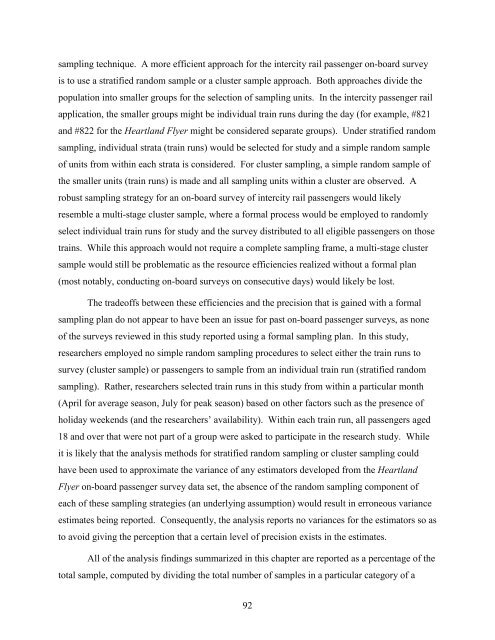Measuring the Benefits of Intercity Passenger Rail: A Study
Measuring the Benefits of Intercity Passenger Rail: A Study
Measuring the Benefits of Intercity Passenger Rail: A Study
Create successful ePaper yourself
Turn your PDF publications into a flip-book with our unique Google optimized e-Paper software.
sampling technique. A more efficient approach for <strong>the</strong> intercity rail passenger on-board survey<br />
is to use a stratified random sample or a cluster sample approach. Both approaches divide <strong>the</strong><br />
population into smaller groups for <strong>the</strong> selection <strong>of</strong> sampling units. In <strong>the</strong> intercity passenger rail<br />
application, <strong>the</strong> smaller groups might be individual train runs during <strong>the</strong> day (for example, #821<br />
and #822 for <strong>the</strong> Heartland Flyer might be considered separate groups). Under stratified random<br />
sampling, individual strata (train runs) would be selected for study and a simple random sample<br />
<strong>of</strong> units from within each strata is considered. For cluster sampling, a simple random sample <strong>of</strong><br />
<strong>the</strong> smaller units (train runs) is made and all sampling units within a cluster are observed. A<br />
robust sampling strategy for an on-board survey <strong>of</strong> intercity rail passengers would likely<br />
resemble a multi-stage cluster sample, where a formal process would be employed to randomly<br />
select individual train runs for study and <strong>the</strong> survey distributed to all eligible passengers on those<br />
trains. While this approach would not require a complete sampling frame, a multi-stage cluster<br />
sample would still be problematic as <strong>the</strong> resource efficiencies realized without a formal plan<br />
(most notably, conducting on-board surveys on consecutive days) would likely be lost.<br />
The trade<strong>of</strong>fs between <strong>the</strong>se efficiencies and <strong>the</strong> precision that is gained with a formal<br />
sampling plan do not appear to have been an issue for past on-board passenger surveys, as none<br />
<strong>of</strong> <strong>the</strong> surveys reviewed in this study reported using a formal sampling plan. In this study,<br />
researchers employed no simple random sampling procedures to select ei<strong>the</strong>r <strong>the</strong> train runs to<br />
survey (cluster sample) or passengers to sample from an individual train run (stratified random<br />
sampling). Ra<strong>the</strong>r, researchers selected train runs in this study from within a particular month<br />
(April for average season, July for peak season) based on o<strong>the</strong>r factors such as <strong>the</strong> presence <strong>of</strong><br />
holiday weekends (and <strong>the</strong> researchers’ availability). Within each train run, all passengers aged<br />
18 and over that were not part <strong>of</strong> a group were asked to participate in <strong>the</strong> research study. While<br />
it is likely that <strong>the</strong> analysis methods for stratified random sampling or cluster sampling could<br />
have been used to approximate <strong>the</strong> variance <strong>of</strong> any estimators developed from <strong>the</strong> Heartland<br />
Flyer on-board passenger survey data set, <strong>the</strong> absence <strong>of</strong> <strong>the</strong> random sampling component <strong>of</strong><br />
each <strong>of</strong> <strong>the</strong>se sampling strategies (an underlying assumption) would result in erroneous variance<br />
estimates being reported. Consequently, <strong>the</strong> analysis reports no variances for <strong>the</strong> estimators so as<br />
to avoid giving <strong>the</strong> perception that a certain level <strong>of</strong> precision exists in <strong>the</strong> estimates.<br />
All <strong>of</strong> <strong>the</strong> analysis findings summarized in this chapter are reported as a percentage <strong>of</strong> <strong>the</strong><br />
total sample, computed by dividing <strong>the</strong> total number <strong>of</strong> samples in a particular category <strong>of</strong> a<br />
92
















